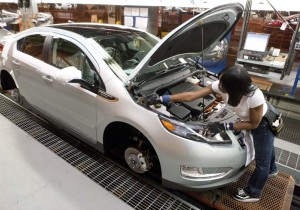Even as it confirms plans to add another 1,000 jobs to boost its battery car program, General Motors said it is contemplating whether to expand production of the new Chevrolet Volt.
GM CEO Dan Akerson, while stopping short of saying the Volt will be a runaway hit, says he has asked for a study of whether it’s feasible to ramp up production of a vehicle that was supposed to undergo a slow and cautious roll-out reflecting both uncertain demand and the challenge of producing an entirely new type of powertrain technology.
For 2011, GM originally targeted production of just 10,000 Chevy Volts, with the figure to climb to 45,000 in 2011. But speaking at the official launch of production at the GM assembly plant in Detroit, Tuesday morning, Akerson said, “My sense is there is going to be a lot of demand for this vehicle.”
(Akerson spoke publicly for the first time after GM’s November 18 IPO, a stock offering he described as “successful beyond expectations.” Click Here for that story.)
The so-called “Poletown” assembly plant is currently operating on only one shift so GM has at least the plant capacity to bump up Volt production. Battery-pack production could be a potential bottleneck, however, if demand for the Volt takes off.
“We have to look at that,” said GM President Mark Reuss, who added GM has also committed to export a version of the Volt, the Opel Ampera, to Europe in late 2011. Both Volt and Ampera will be sold in China, and GM also is considering exporting Volts to Australia, Reuss said.
Tom Stephens, the GM vice chairman who was put in charge of the study, said the maker wants to insure production doesn’t outstrip demand – a mistake GM has made in years past with other “halo” products. “My sense is it won’t,” he stressed.
However, Stephens declined to say how long it will take GM to expand Volt production. “I can’t say,” he cautioned, noting the development of key components such as battery packs, power controls and electric motors are already being refined.
For the moment, the basic lithium-ion cells used for Volt must be shipped in from South Korea, then assembled at a GM-run factory in suburban Detroit. But battery vendor LG Chem is setting up a plant in Western Michigan that will eventually handle the basic chemistry closer to GM.
Even if the Volt expansion is derailed, it now appears the automaker is ready to place more resources on its “electrification” efforts. Akerson announced GM plans to add 1,000 engineers and researchers to its battery vehicle engineering base, something that will be needed to expand its expertise and maintain the company’s leadership in the development of electric vehicles
The new jobs will build on GM’s strategic decision to treat the development, validation and manufacture of automotive batteries, electric motors and power control technologies as core competencies, Akerson said.
Some competitors have chosen to turn to outside partners or contractors. Toyota, for example, recently announced plans to use Silicon Valley-based start-up Tesla Motors to oversee the development of its 2012 RAV4-EV – though Toyota is also working on other battery car efforts in-house.
“GM is going to lead the industry in the adoption of various vehicle electrification technologies, whether it’s electric vehicles with extended-range capability, like the Chevrolet Volt, or the recently introduced electric-assist technology that will debut on the 2012 Buick LaCrosse,” Akerson said.
“We want to give our customers energy choices other than petroleum and to make the automobile part of the solution when it comes to the environment,” he added.
GM’s accumulated experience and expertise in batteries, electric motors and power controls will ensure GM provides the best possible electric vehicle choices to customers around the world, Akerson stressed.
Former vice chairman Robert Lutz, who is generally regarded as the father of the Volt project, said the plug-in hybrid’s recent string of “Car of The Year” awards – including Automobile Magazine’s Automobile of the Year, Green Car Journal’s Green Car of the Year, Motor Trend’s influential Car of the Year, and Car And Driver’s 10-Best — vindicates GM’s 2007 decision to go forward with the Volt.
So does news that General Electric will purchase 15,000 of the battery cars, part of the industrial giant’s goal of converting at least half of its vast sales and service vehicle fleet to electric propulsion.
“We had some contentious meetings,” said Lutz, who was a guest at the Volt roll-off ceremony. He recalled one in which former chairman Richard Wagoner pointed to the 1990s-era GM EV1 and said, “Bob we lost $1 billion on our first electric vehicles. How much are we going to lose on this one?”
But Volt project inched forward despite the reservations of GM’s finance staff, Lutz said. “No other company in the world could have done the Volt. No other company in world had the intellectual property and the skill to do the Volt,” he said.
“GM’s biggest challenge is its reputation, and the Volt will go a long towards changing the reputation,” he said.

